The Transformation Era (1990-2010)
The fall of the Berlin Wall would not appear to have been a monumental event for the Canadian Navy, as the summer of 1990 found the East Coast task group preparing as usual for the annual NATO fall exercise in north European waters. For all the outward nonchalance, however, behind the scenes, the collapse of the Soviet Union as the nominal Cold War opponent presented senior naval commanders cause for concern. The Canadian Navy’s raison d’être for the previous 40 years was gone, just as the service was at its post-Second World War nadir; increasingly derided in the media as “rusted-out” and irrelevant, the Canadian fleet was essentially unchanged from that of 1975.
Plans existed for the mainstay of the fleet, the venerable steam-powered frigates commissioned in the 1950s, to be withdrawn for sequential replacement by a new class, the Canadian patrol frigates, or CPFs. Like the ships they were replacing, the patrol frigates were designed for north Atlantic ASW. The program also coincided with the planned withdrawal of the 20-year-old Iroquois-class destroyers (DDH-280s) for a mid-life upgrade (the TRUMP or Tribal Update and Modernization Program). These plans meant the fleet’s capacity for operations would be severely diminished for the next half-decade, and already there were calls to scale back both programs as part of the anticipated “peace dividend.”
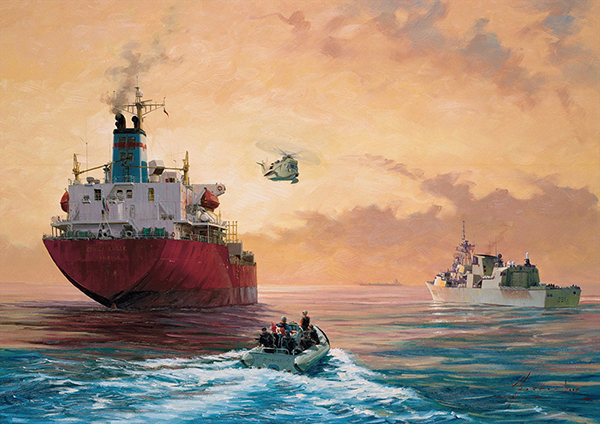
John Horton, Operation Apollo, shows a Canadian boarding party approaching a merchant tanker to search for material or activity indicating the presence of terrorists onboard.
Like the rest of the world, Canada was kicked out of the summer doldrums by Saddam Hussein’s early-August invasion of Kuwait. Most observers were caught further off guard when it was announced that Canada’s military response to the American-led Operations Desert Shield and Desert Storm was the dispatch of a naval task group to the Persian Gulf, contrary to speculation that participation would be limited to a post-hostilities army peacekeeping force. If anything demonstrated how badly prepared the Canadian fleet had been to take on the presumed Soviet adversary, it was the deep anxiety now felt at going to war against an Iraq equipped largely with Soviet-style forces buttressed by the deadly French Mirage fighter and Exocet missile combination that had severely damaged the USS Stark only a few years earlier.
But the aging destroyer Athabaskan, the steam frigate Terra Nova, and the supply ship Protecteur did sail, hastily upgraded with new command and control (C2) systems and strapped-on modular weapons such as the Phalanx CIWS (Close-in Weapon System) anti-missile Gatling gun and Harpoon anti-ship missiles obtained from the CPF and TRUMP projects. Nor would their deployment prove to be a “one-off” crisis response. Over the ensuing two decades, the southwest Asia theatre of operations was to become a “home away from home” for the Canadian Navy, with every major surface warship in the fleet seeing service in the region at least once, and several on three or more deployments. To be sure, as will be seen over the next few pages, the fleet has been busily engaged elsewhere around the globe, but the southwest Asia deployments have provided a completely unanticipated boost to the fortunes of the modern Canadian Navy. The two decades spanning the arrival of the twenty-first century have witnessed an unprecedented introduction of modern technologies and changing concepts of operations in navies and militaries around the world, such that the period has been styled variously as “the revolution in military affairs (RMA)” or “the age of transformation.” The Canadian naval experience of many of these new technologies and operational concepts has been a direct result of the Gulf deployments, so it is no small claim that those have been a catalyst for the transformation of the Canadian fleet from a Cold War relic to one of the world’s leading medium power navies.
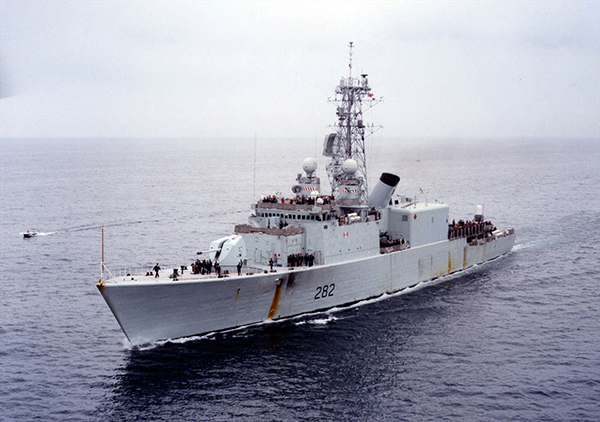
Visibly worn from her seven-month deployment to the Persian Gulf, which included 49 straight days at sea, Athabaskan returns to Halifax, April 1991.
That first Gulf war deployment in the summer of 1990 marked a dramatic break from many of the presumptions guiding employment of the Canadian Forces. For the first time in Canadian military history, participation in a major conflict was to be defined not in terms of the land force contribution, but by the exclusion of it and the inclusion of the contributions of the other services. It turned the Canadian Navy’s world upside down — optimized for open-ocean anti-submarine warfare in the sub-Arctic waters of the north Atlantic and Pacific oceans, it suddenly found itself facing a primarily airborne threat in confined tropical waters.
But the sudden deployment also confirmed many basics were sound — such as the immense flexibility of general-purpose ship designs; the basic competence of well-trained sailors and practiced staff officers; and the immense benefits of investing in standardizing major systems, especially communications, with the United States Navy.
Indeed, these had all come together in the last few years of the Cold War, the real key being the fitting of Canadian flagships with American satellite communications and computerized command and control tools, so that by the late 1980s Canadian task group commanders were regularly exercising the ASW commander function in major NATO exercises. The job of Canadian ships in the gulf, therefore, was not a great leap. Even though their poor anti-air defences prevented them from holding a place in the forward operating areas of the northern Gulf, when USN commanders needed someone to coordinate the activities of the many other smaller navies in the southern Gulf, they delegated tactical control of the Coalition Logistics Force to the Canadian task group commander, which resulted in Navy Captain “Dusty” Miller becoming the only non-U.S. Navy officer assigned a subordinate warfare commander role in that conflict. Communications compatibility with the USN allowed Miller to pass information and orders up and down, between American commanders preoccupied with managing the very active war against Iraq, and the bulk of the coalition members whose ships did not enjoy communication equipments compatible with the USN. In a parallel development, Miller noted that the nature of the higher direction of warfare — associated now with coalition as opposed to alliance partners — was changing, leading him to suggest a re-definition of C2 from “command and control” to “cooperation and coordination.”1
That first Gulf war sparked other significant shifts in Canadian military thinking. For one, the bold tactical decision by the original task group commander, Commodore Ken Summers, to station his ships in the central Gulf, well within Iraqi air attack range and notwithstanding the limited self-defence capabilities of the ships, was an inspired declaration that ours was a fighting navy not afraid to go in harm’s way. For another, one of the factors that gave Summers the confidence to take that step was the commitment of a squadron (and eventually a wing) of CF-18 Hornet fighters to fly top cover for the naval forces in the Gulf — the first expeditionary combat deployment in modern air force history, which was also notable as it was conducted in concert with the U.S. Navy, instead of its traditional partner, the U.S. Air Force. And then, when Summers was shifted ashore to take command of all the Canadian Forces gathering in the Middle East, the establishment of his Bahrain base as the first true deployed joint headquarters (JHQ) in Canadian military history — and with a sailor in charge at that — heralded a true revolution in Canadian military affairs.
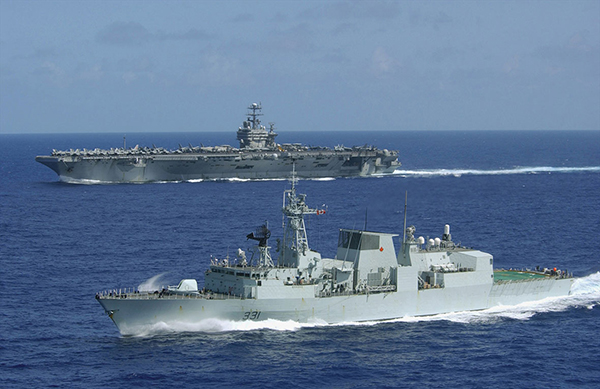
Through the late 1990s, the Halifax-class frigates operated as fully integrated elements of United States Navy (USN) carrier battle groups in the Persian Gulf region, such as Vancouver here with the USS John C. Stennis.
After the March 1991 ceasefire, the Canadian government wished to maintain a presence in the region, but the state of the fleet transition limited the effort, as had been expected. However, the introduction to the fleet in the mid-1990s of the highly capable Halifax-class frigates suggested opportunities to renew deployments, and 1995 saw two ships dispatched on separate missions. The first, HMCS Fredericton early in the year, was purely an effort to assist in the promotion of Canadian technology at various locations in the Gulf States. But the second saw Calgary operating not simply “attached” but as a fully “integrated” unit of the USS Abraham Lincoln carrier battle group, because of special access to high-level communications codes and equipment that would allow full utilization of the new Canadian frigate. Calgary’s deployment was a great success — among other things, having a shallower draft than most USN vessels, it spent much of August and September patrolling the northern Gulf off the mouth of the Shatt-al-Arab just outside the Iraqi 12-mile (19 kilometre) territorial limit — and became the model for future deployments. With the ongoing transition of the fleet, the momentary quiescence of Saddam, and the higher priority to provide frigates to the Adriatic for the NATO embargo of the Former-Yugoslavia, however, it would be two more years before another frigate could participate with the Multinational Interception Force.
Before continuing that story, it is necessary to go back in time to pick up another thread in the “catalyst for transformation” theme. In the fall of 1992, in response to the slide of Somalia into failed-state status, HMCS Preserver was dispatched to support the deployment of the Canadian Airborne Regiment in the distribution of humanitarian aid. The deteriorating situation on the ground resulted in a constantly changing mission, one aspect of which was the inability to find a safe initial location ashore for the mission commander’s headquarters. The solution was to reconfigure the ship’s operations room as a floating JHQ — a measure fairly obvious to any navy that operates amphibious forces, but to the supposedly unified Canadian Forces (which in truth had never operated together as a tri-service “joint” force in actual combat) this was a radical departure. The success of at least this aspect of the ill-starred Somalia mission would be recalled a decade later when Chief of the Defence Staff, General Rick Hillier embarked upon his so-called transformation of CF command and control. More immediately, it led, within the Canadian Navy, to internalization of the idea that the long-overdue replacement of the replenishment ships should include the requirement that they be able to act as an afloat JHQ. Ironically, rather than speeding acceptance of the new tanker acquisition, an argument can be made that trying to define the level of jointness desired by the various services has delayed the acquisition of what is now called the JSS (joint support ship). Nonetheless, the concept has been a powerful catalyst for the transformation of not only the Navy but also the entire Canadian Forces.
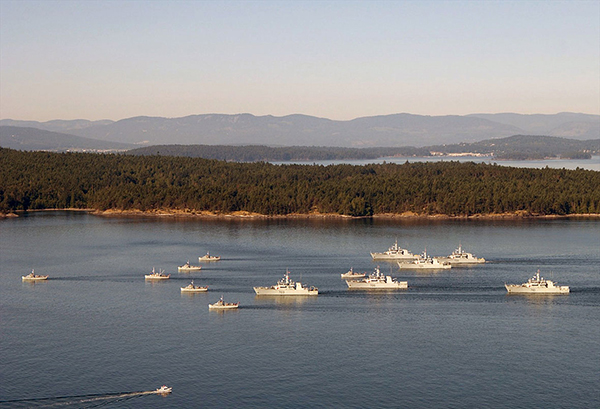
Maritime Operations Group 4, including all six of its assigned Kingston-class coastal patrol vessels, does a formation steam through the Gulf Islands, British Columbia.
With the “new world order” proving to be rather disorderly and in need of occasional Canadian naval intervention, modernization of the fleet had not been substantially delayed and proceeded largely as anticipated in the 1987 fleet plan. Even as the task group sailed for the Gulf in August 1990, the lead ship of the CPFs, Halifax (FFH-330), was undergoing acceptance trials. The remaining steam frigates were decommissioned in succession so that their crews could undertake conversion to the new types; the last to go was Nipigon (DDH-266) in 1998. Over the course of the last decade of the twentieth century, the Navy accepted the four rebuilt ships of the Iroquois class, as well as 24 new ships — besides the 12 patrol frigates, there were 12 Kingston-class (PB-700) maritime coastal defence vessels (MCDVs), replacing the 1950s vintage Bay-class minesweepers for use primarily with the Naval Reserve for the renewal of a mine countermeasures (MCM) capability and basic naval officer training. By the end of the decade, the three Oberon-class submarines were gone as well, being replaced by the Victoria (ex-Upholder) class of four diesel submarines acquired from the Royal Navy. In the year 2010, only the AORs Protecteur and Preserver remain of the Cold War fleet. If for no reason beyond the physical composition of the fleet, the last two decades has witnessed the transformation of the Canadian Navy. At the cusp of the Navy’s Centennial, Canada has in its service arguably the best-balanced and most capable fleet in its history.
But the transformation extends to other levels as well. Throughout the latter stages of the Cold War, as the American and Soviet superpowers settled into their nuclear stand-off and Canadian fleet operational capability increasingly diminished, crisis response actions were a rarity and it was possible for sailors to predict their annual sailing schedules in accordance with the major NATO exercises.
Through the 1990s, the change in composition of the fleet was paralleled by a change in the longstanding relationship with NATO. Canada continued the practice of consistently contributing a ship to the Standing Naval Force Atlantic (STANAVFORLANT), but the availability of hulls and the press of other commitments precipitated a subtle but noticeable shift in the priority previously extended to what had almost come to be presumed an obligation. The first indication came in the immediate wake of the 1991 Gulf War when Restigouche, originally intended to replace one of the ships in the Gulf, was given the NATO assignment — the first West Coast ship to do so, and indeed the first Canadian ship to join STANAVFORLANT without a helicopter since its inception in the 1960s. Later in the decade, occasionally a tanker would come to pick up the duty (one had frequently been part of the group, but never as a replacement for a destroyer or frigate). The role was still an important one, as witnessed by Canada continuing to fill a turn in the rotating command of the NATO group, which came about twice in the course of the decade, and each time with one of the modernized (“TRUMP’d”) Iroquois-class destroyers as the flagship, a role for which it was now truly fitted. As fate would have it, both those year-long assignments — in 1993–94 and 1999–2000 — coincided with the two occasions when STANAVFORLANT was deployed out-of-area to the Adriatic Sea for operations against the Former-Yugoslav Republic, and again the higher quality of command and control suite fitted in the Canadian destroyers was critical to successful coordination of the mission. However, a truer harbinger came in 1998, when the NATO-assigned frigate Toronto was detached from the NATO squadron to proceed to the Gulf as an immediate response to the United Nations call for additional forces to pressure Saddam Hussein to comply with U.N. weapons-inspection access. That type of re-assignment — and the gapping of the NATO commitment until the next scheduled deployment — would become an habitual response to the Canadian government’s need for a forward-deployed frigate. Canada’s naval commitment to NATO remains of continuing value to the Alliance. Indeed, when a change in the Alliance’s concept of operations meant the reconstitution of STANAVFORLANT in 2006 in favour of a “Standing NATO Maritime Group” (SNMG-1), it was Canadian Commodore Denis Rouleau who was assigned to oversee the new force’s year-long workup to fully operational status, a command he conducted from a succession of Iroquois-class destroyers. As NATO itself changes, Canadian warships have been part of the action, with the frigate Toronto participating in the circumnavigation of Africa in 2007 (an incredible expedition when one stops to think of it), and Winnipeg found itself at the front of the force’s fight against Somali pirates in 2009.
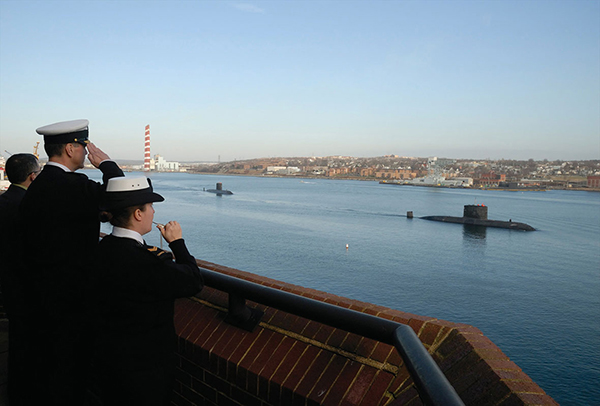
Leading Seaman Tammy Comeau pipes the “still” as Commander Maritime Forces Atlantic Rear-Admiral Dean McFadden returns the salute of the submarines Corner Brook and Windsor, 21 December 2006.
The decreasing emphasis on NATO reflects an expansion of Canadian horizons beyond Europe, and as the country looks farther afield, the global reach of the fleet has positioned the Navy perfectly to contribute. If the “Persian Excursion” was the last war cry of the Cold War fleet, Canada’s “New World Order Navy” very quickly found itself engaged at a higher operational tempo, as real-world brush-fire crises replaced the routine of peacetime exercises. The fisheries crisis on the Atlantic Grand Banks, illegal Chinese immigration on the Pacific coast, challenges to our Arctic sovereignty, and continued instability in the Caribbean basin all ensured gainful employment in home and hemispheric waters. Further abroad, the new frigates and modernized destroyers have proven to be showcases of Canadian technological know-how, and even the two supply ships have been dispatched for humanitarian assistance operations to places as diverse as hurricane-ravaged Florida and civil war-torn East Timor, in addition to their customary fleet replenishment role. The planned annual cycle of exercises promulgated in the fleet OPSKED (operations schedule) with traditional names like Ocean Safari, Teamwork, MARCOT, and RIMPAC, invariably has been overtaken with real-world operations with often only too-appropriate designations such as Friction (Persian Gulf, 1990–91), Deliverance (Somalia, 1992–93), Sharp Guard (the Adriatic Sea, 1992–95), Forward Action (Haiti, 1993–94), Ocean Vigilance (the Grand Banks “Turbot War,” 1995), Persistence (the Swissair crash recovery in St. Margaret’s Bay, 1998),Toucan (East Timor, 1999–2000), Megaphone (the boarding and recovery of the GTS Katie in the Gulf of St. Lawrence, 2000), Unison (the relief effort in the wake of Hurricane Katrina, 2005), Chabanel (support to the Royal Canadian Mounted Police [RCMP] for a drug bust in West Africa’s Gulf of Guinea, 2006), and Horatio (Haiti again, but for hurricane relief, 2008). Significant for their listing as operations (even though they are in fact domestic exercises by the standard definition of the terms) have been the increasingly bold forays of the Navy into the high Arctic, culminating in Operation Nanook, which saw the frigate Fredericton. coastal defence vessel Summerside, and submarine Corner Brook operating with other Canadian Forces and the Coast Guard into the Northwest Passage in August 2007.
And sailors found their skills in high demand also in diverse inland employment: as observers in Cambodia (Op Marquis, 1992), the Former-Yugoslavia (Op Bolster, 1991–94), and Darfur (Op Augural, 2005–08); as key members of the Strategic Advisory Team to the Afghan government in Kabul (Op Argus, 2005–08); and in general support of broader operations in Afghanistan (Op Athena, 2005 to date), where the unique skills of the Navy’s clearance divers at disposing of improvised explosive devices (IEDs) have earned special recognition, including the award of the Star of Courage to Petty Officer 2nd Class Jim Leith for his “act of conspicuous courage in circumstances of great peril” in the fall of 2006. Leith portrayed the nonchalance typical of sailors just going about their professional business in these various activities, dismissing his dismantling of the explosive device with a simple, “These IEDs are technically not very sophisticated. I felt I was competent enough to disable it. A good dose of fear keeps you sharp.”2
But returning to the main thread of the story, it is the Gulf deployments that really have come to define the modern Canadian naval experience. After a break from the initial forays in 1995 to allow completion of the fleet transition, by 1997 the Navy was ready to resume frigate deployments to the Gulf region. As had been established previously by Calgary’s mission, the next ship to take on the task (the Regina, another from the West Coast) was also fitted with the full communications suite needed for high-level access, but by now it was recognized that the level of Canadian technical and communications interoperability with the USN was sufficient that Canadian ships could replace American vessels one-for-one in the order of battle. As such, a new twist on this mission was that Regina undertook the full regime of training and workups and made the transit to the Gulf as part of the San Diego-based USN surface action group with which it was designated to operate. The success of that effort led to the practice being regularized.
Although only one ship was to be sent each year, for a six-month period away from home port (meaning a gapping of the Canadian presence in the Gulf), the continuing non-compliance of Saddam Hussein with U.N. inspection requirements soon led to a more forceful and sustained Canadian presence. A flurry of United Nations Security Council Resolutions in 1997–98 culminated in the coalition (primarily U.S.-U.K.) Operation Desert Thunder, for which, as we have seen, the Canadian frigate assigned to STANAVFORLANT was diverted to the Gulf in support of the Multinational Interception Force (MIF). Even after that coalition drubbing, Saddam’s compliance was short-lived, so the Chrétien government undertook to bolster its commitment to the MIF. What eventually became known in Canada as Operation Augmentation saw the deployments of a further succession of five frigates integrated in USN carrier battle groups and surface action groups in the three-year 1998–2001 period. Saddam’s intransigence toward the U.N. increased such that HMCS Winnipeg (the last frigate so deployed) had to perform several non-compliant boardings through the spring and summer of 2001. Significantly, for its last patrol in July 2001, Winnipeg’s captain, Commander Kelly Williams, was designated the on-scene commander for the northern Gulf, a first time for a coalition warship — again, full “connectivity” on a form of classified internet known as the Coalition Wide Area Network or COWAN, was the key to performing this major warfare responsibility.
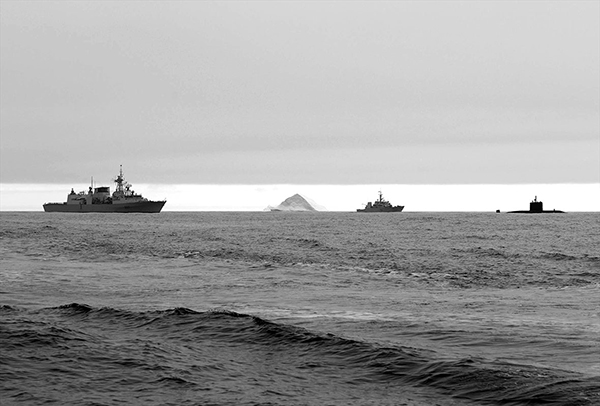
Left to right: HMC Ships Fredericton, Summerside, and Corner Brook sail in formation past an iceberg during Operation Nanook, August 2007.
Another factor was the increasing persistence of the Canadian presence. The deployments through the 1990s did work to increase the familiarity of Canadian crews with the radical new satellite and computer-based communications technologies. But the Gulf deployments, for all of their individual effectiveness, being of such an irregular nature had failed to make a lasting impression on USN regional commanders — until, that is by 2000– 01, when the steady succession of ships in-theatre made our presence an expected and accepted feature, resulting in the recognition accorded Winnipeg.
The decade of Gulf deployments had a deeper effect on the Navy’s psyche than just technical competence. The Canadian Navy embarked also upon an intellectual revolution through the 1990s, seeking a better understanding of the meaning of sea power to medium power nations such as Canada, as distinct from the global force projection capabilities particular to the U.S. Navy. The articulation of a strategic vision for its purpose in the post–Cold War world was shaped in large measure by a thorough exploration of the meaning of the Gulf deployments. June 2001 saw the publication of Leadmark: The Navy’s Strategy for 2020, which pointed variously to the utility of working in combination with alliances or coalitions, to the merit of interoperability with the U.S. Navy, and to the shift of naval operations into the littorals as an enabler of air and land operations. The struggle to articulate a vision for the Navy in a constantly changing global military environment has been re-engaged, with the intent to promulgate an updated strategic approach in 2010.
But in 2001, the Navy hardly had time to digest Leadmark, when in the aftermath of the 9/11 Al-Qaeda attacks, NATO invoked Article 5 of its Charter and the United Nations Security Council passed a series of resolutions authorizing collective action against terrorists, and Canada promptly began to implement its “new” naval strategy. As has been our nation’s practice in the past, the Navy, once again, was the first responder to a major crisis overseas. Within hours of the Chrétien government committing Canadian Forces to join in the U.S.-led Operation Enduring Freedom (OEF), the frigate with STANAVFORLANT was detached to join a USN carrier battle group in the Arabian Sea, and within the month the West Coast frigate that had been preparing to deploy under the latest iteration of Op Augmentation sailed to join another carrier group. The main Canadian OEF effort fell under the national Operation Apollo, initially with the dispatch of a three-ship task group from Halifax with an embarked commodore, just as had transpired in 1990. The operations in this second Gulf War lasted a full two years and evolved through what can be seen in hindsight as four distinct phases. Each was an impressive achievement in its own right, demonstrating the amazing flexibility Canada has in its modern general-purpose fleet.
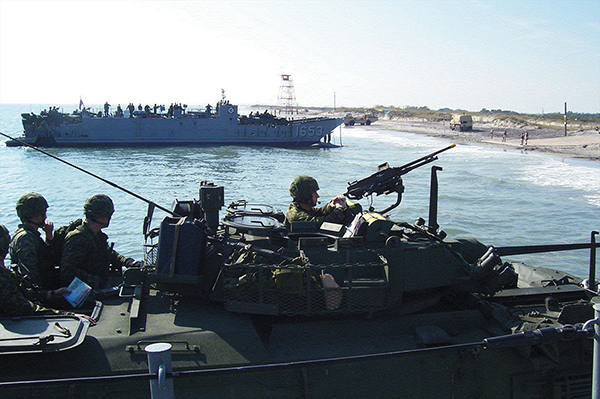
A LAV-III crew of the Royal 22e Regiment makes an amphibious landing during an exercise proving the Standing Contingency Force concept of operations, November 2006.
This time, contrary to the earlier experience, the modernized destroyers and frigates constituted a truly imposing force, and immediately upon arrival of Iroquois and Charlottetown in the Arabian Sea in November 2001 — after a 13,000 kilometre voyage and without need to put into port to replenish or re-equip — the Canadian task group was assigned the close escort of the U.S. Navy amphibious ready groups operating close inshore off Pakistan, including the direct “TACON” (tactical control) of U.S. Navy Aegis destroyers, a rare signal of USN trust in an ally. By January 2002, at the height of this first phase, there were six Canadian warships in the region (one-third of the entire surface fleet). As U.S. Marine operations in Afghanistan wound down (incidentally, replaced in Kandahar by the Canadian Princess Patricia’s Light Infantry brigade group), the second phase went into full swing with attention shifting to the search for escaping leadership of Taliban and Al-Qaeda terrorists. The shortest path to their Horn of Africa bases, after making their way through Iran, was by sea across the Gulf of Oman (this area became known by its acronym as the “GOO,” which also described the hot and humid conditions). Coinciding with the arrival of naval forces from other coalition partners into the area, the Canadians quickly took charge of this effort, closing off the GOO through the spring and summer of 2002 as an escape route. The third phase began with the buildup in the fall of 2002 of coalition forces for operations against Iraq, and continued through the war there. Although Canada opted not to participate directly in that conflict, it was recognized that the stream of coalition shipping through the Strait of Hormuz would be a “honey-pot” — an attractive target sure to lure terrorist attacks. The task group organized hundreds of close escorts through the Strait, which went off without major incident.
All of this effort was coordinated under the USN as part of Operation Enduring Freedom, but in the winter of 2002–03 the shifting of U.S. attention onto Iraq left many coalition partners — including Canada — uneasy. The fluid nature of operations at sea, unlike the way those on land tend to evolve, means they cannot be separated by simple demarcations on a map, and the subtle distinction was lost on many Canadian observers then and since. U.S. naval commanders at the time were aware of the national sensitivities, and developed a solution to provide some arms-length separation of Operation Enduring Freedom from Operation Iraqi Freedom (OIF). Key to this was the creation of a new task organization command structure, which among other things elevated the Canadian-led task group in the Gulf of Oman to full task force status (the distinction between “group” and “force” indicating a potent increase in power), with a separate reporting chain direct to the coalition naval commander in Bahrain, rather than through an American admiral embarked in a USN carrier. Although the Canadian command of Coalition Task Force 151 has been misinterpreted by politicians and academics who sometimes seem wilfully inclined not to understand national command and control structures, the government of the day fully understood the distinctions and was comfortable with the navy’s actions. Indeed, the case can be made that Commodore Roger Girouard’s command of CTF 151 not only provided the government of Canada a much-fuller range of political options in managing its response to the crisis, but also it quite probably was instrumental in keeping the Enduring Freedom coalition together at a politically delicate time. U.S. Ambassador Paul Cellucci said it best when he observed that, “Canadian naval vessels, aircraft and personnel … provide more support indirectly to this war in Iraq than most of the 46 countries that are fully supporting our efforts there.”3
The final phase began as operations in Iraq wound down, for even with “active” operations over, the value of regular merchant shipping through the Strait of Hormuz, as well as the ongoing hunt for Al-Qaeda, pointed to the need to maintain a Canadian naval presence in the Arabian Sea region. By the summer of that year, only the frigate Calgary remained in-theatre, and its return to Esquimalt in December 2003 marked the end of the largest sustained Canadian naval operation since the Korean War. Operation Apollo had required the effective mobilization of the Canadian Navy — the deployment of practically the entire major surface fleet (except for the one destroyer and the one frigate in extended refits), and nearly every one of the 4,200 sailors of all ranks and trades in sea-going billets. With a contribution typically constituting less than 20 percent of coalition naval resources, Canadian sailors accomplished some 50 percent of the measurable achievement: altogether they completed some 600 of the nearly 1,300 boardings, an average of nearly two a day for the duration of the operation; Calgary alone conducted 92 escorts through the Strait of Hormuz. But the real Canadian naval success was in leading the coalition effort at sea. Our navy was the first major fleet to arrive after the U.S. Navy. Many of the 49 other participating nations dispatched a frigate or supply ship to establish a presence, but most had little experience operating with the other fleets. Our ships’ unique communications “interoperability” with the USN, plus our national experience of multilateralism, made it natural for the USN to delegate command of this fleet to the Canadian commodore. Coalition building is perhaps the most under-appreciated of the naval roles in the war against terrorism, and yet it is the most quintessentially Canadian. Command of Task Force 151 was the first operational-level command — the largest area of responsibility and span of control — exercised by a senior Canadian officer in an active theatre since the Second World War, and it was a singular national achievement that was lost sight of in the false debate overparticipation in the war against Iraq.
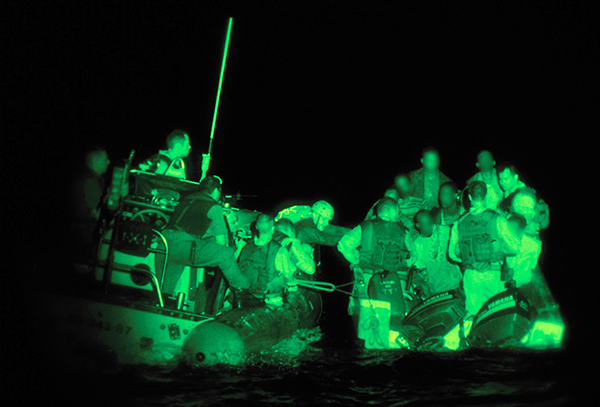
A night vision scope view from the frigate Winnipeg of her boarding party intercepting a boat of Somali pirates, April 2009.
The Navy was supposed to take an “operational pause” to recover from the effort, but almost immediately, in January 2004, the frigate Toronto deployed back to the region, integrated with the USS George Washington carrier battle group. Operation Altair, the Canadian codename for the continuing naval presence in the region, continues to this day. It was envisioned as a return to the Op Augmentation single-ship deployments; however, the capabilities of the ships and the prowess of the crews quickly re-established their reputation, and opportunities have frequently arisen for the ship captains to exercise what are known as “Pulse Group Command” of small formations of multinational warships on focused operations. One of the most successful of these resulted in the captain of HMCS Ottawa being awarded the U.S. Meritorious Service Medal for that ship’s tour in 2007, the citation reading in part, “Commander [Darren] Hawco’s brilliant operational acumen included a high visibility boarding operation against a vessel suspected of trafficking international terrorists, and crucial escort duties for a damaged United States submarine transiting the treacherous Straits of Hormuz. His exhaustive efforts greatly improved maritime security and raised the bar for coalition operations.”4 The increasing success of those single-ship deployments suggested a number of opportunities that could be exploited by the return of a full Canadian task group to the region, and so it came to pass that Commodore Bob Davidson exercised command of CTF 150 for the three months of June-September 2008, from his flagship Iroquois, with the frigate Calgary and supply ship Protecteur joining the other coalition forces just in time to anticipate the sudden increase in pirate activity off Somalia. In the fall of 2008, the only Halifax-class frigate to have not yet deployed to the southwest Asia theatre finally did so, when HMCS Ville de Québec was detached from duties with NATO’s standing maritime group in the Mediterranean to provide escort for World Food Programme emergency aid shipments into Mogadishu, Somalia.
The successful transformation of the 1990s evidently delivered just the navy Canada needed to respond decisively to a range of domestic and international crises. But the aging of the fleet speaks to the urgency of getting on with renewal. The Halifax-class frigates were laid down in the early 1990s (nearly two full decades ago); the Victoria-class submarines first entered British service in the early 1980s (the better part of three decades ago); the destroyers and supply ships were commissioned in the early 1970s (coming on four decades ago).The Canadianization refit of the submarines is progressing well, with Victoria and Corner Brook due to re-enter service during 2010.A contract to perform the Halifax-class modernization has been signed, which will see the 12 frigates sequentially withdrawn from service over the next decade for their mid-life refit. But uncertainty lingers over the scope and timing of the Joint Support Ship tanker replacement project, and a new class of vessels designed for duty in the high north (the Arctic offshore patrol vessel, or AOPV) is still in the project definition stage. More critically, the government has yet to agree to replace the Iroquois-class destroyers, which are reaching the natural end of their hull service lives. Their looming retirement, coincident with withdrawal of the Halifax class for upgrade, means that for a critical few years in the middle of the next decade, Canada could have only four major surface warships available for deployment on a contingency operation.
This chapter in the history of the Canadian Navy looks to be ending much as it began — with the naval service facing a diminished capacity for operations for at least the next half-decade. But if history is any guide, as new challenges come along from unexpected quarters, the Canadian Navy is sure somehow to rise to the occasion.
Author: Richard H. Gimblett
1 Jean Morin and Richard H. Gimblett, Operation FRICTION: The Canadian Forces in the Persian Gulf, 1990–1991 (Toronto: Dundurn Press, 1997), 88.
2 Darlene Blakeley, “Navy Diver Awarded Star of Courage,” navy website, 01 April 2009.
3 Quoted in Richard H. Gimblett, Operation Apollo: The Golden Age of the Canadian Navy in the War Against Terrorism (Ottawa: Magic Light, 2004), 125.
4 Darlene Blakeley, “U.S. Meritorious Service Medal Awarded to Ship’s Captain,” The Maple Leaf, 11:41 (3 December 2008).